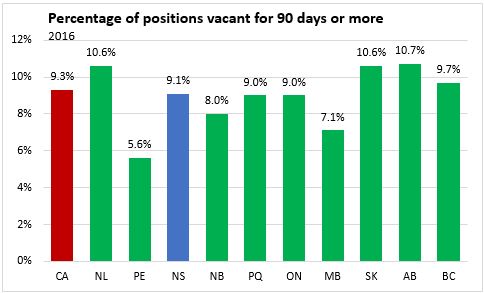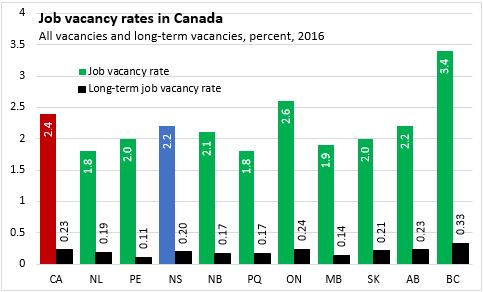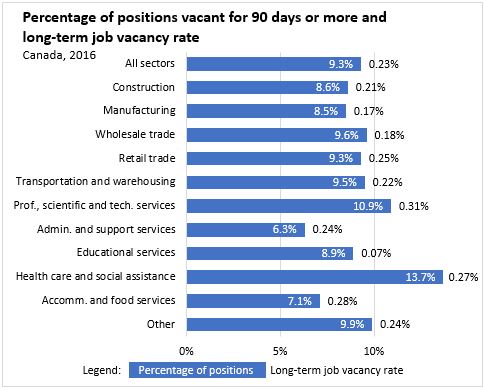The Economics and Statistics Division maintains archives of previous publications for accountability purposes, but makes no updates to keep these documents current with the latest data revisions from Statistics Canada. As a result, information in older documents may not be accurate. Please exercise caution when referring to older documents. For the latest information and historical data, please contact the individual listed to the right.
<--- Return to Archive
For additional information relating to this article, please contact:
March 12, 2018STUDY: LONG-TERM JOB VACANCIES IN CANADA Statistics Canada has released a study exploring long-term job vacancies in Canada. Long-term job vacancies are defined as positions for which recruitment efforts had been ongoing for 90 days or more. The study aims to answer three questions: What is the prevalence of long-term job vacancies in Canada? How do these vacancies differ from other vacant jobs? Is there a link between the duration of the vacancy and the offered wage?
The data for this analysis came from the Job Vacancy and Wage Survey which includes all workplaces in Canada except private households, religious organizations, federal, provincial and territorial governments, international public administrations and all other extra-territorial public administrations.
What is the prevalence of long-term job vacancies in Canada?
In 2016, the number of positions vacant for 90 days or more averaged 35,200 in Canada – about 9% of all job vacancies. The long-term job vacancy rate (long-term job vacancies as a proportion of filled and unfilled positions) was 0.23% in Canada. By comparison, the overall job vacancy rate in Canada was 2.4%.
In Nova Scotia, long-term job vacancies accounted for 9.1% of all job vacancies, below the Canadian average. The proportion of job vacancies which were long-term was highest in the territories, in the oil producing provinces (Alberta, Saskatchewan and Newfoundland and Labrador). The lowest prevalence of long-term vacancies was in Prince Edward Island (5.6%).
Nova Scotia’s long-term job vacancy rate in 2016 was 0.20%, below the Canadian average. The long-term job vacancy rate was highest (outside the territories) in British Columbia (0.33%), Ontario (0.24%) and Alberta (0.23%). Prince Edward Island had the lowest long-term job vacancy rate at 0.11%.


How do these vacancies differ from other vacant jobs?
There were differences in long-term job vacancies across sectors and occupations. The highest prevalence of long-term vacancies in Canada were found in health care and social assistance (13.7%) and professional, scientific and technical services (10.9%), which also had the highest long-term job vacancy rate (0.31%).

By occupation, those in health (16%), management (16%) and natural and applied sciences (14%) had the highest proportions of long-term vacancies. The study suggests that this reflects the increasing demand for health sciences due to the aging population, and could possibly reflect the importance of scientific and management skills in the Canadian labour market.
Positions with higher education and experience requirements tend to take longer to fill, as firms have an incentive to spend more hours per candidate to properly evaluate candidates. When assessing differences in long-term vacancies by skill level, the study finds that management and professional positions were the most likely to remain vacant for more than 90 days. The prevalence of long-term job vacancies was higher among positions which required post-secondary education. However, among long-term job vacancies, the largest share required no minimum education.
Similar trends for long-term vacancies are observed for experience, with the most long-term vacancies requiring less than a year of experience, but the percentage of positions vacant for 90 days or more highest when the job requires 8 or more years of experience.

The highest prevalence of long-term vacancies was found in larger workplaces (those with 500 employees or more), while the long-term job vacancy rate was higher in small workplaces (less than 20 employees). The study suggests that smaller workplaces may face greater recruitment or hiring challenges. By contrast, larger workplaces may be more likely to fill highly skilled positions, which tend to take longer.
Is there a link between the duration of the vacancy and the offered wage?
The study suggests there is a link between the duration of a job vacancy and the offered wages. Offered wages are significantly higher for long-term job vacancies, with employers willing to pay 20% more to fill long-term vacancies compared to those vacant for less than 90 days. The gap varies by sector, occupation, education and experience levels, but persists across many the characteristics explored. After taking the job characteristics into account, the offered hourly wage for full-time long-term vacancies was 5% higher than the offered wage for positions that had been vacant for 15 days or less. When considering both part-time and full-time positions, the wage advantage was 4% for long-term vacancies.
Source: Statistics Canada, Daily Release | Full Report
This report is part of the publication Insights on Canadian Society (75-006-X).
<--- Return to Archive